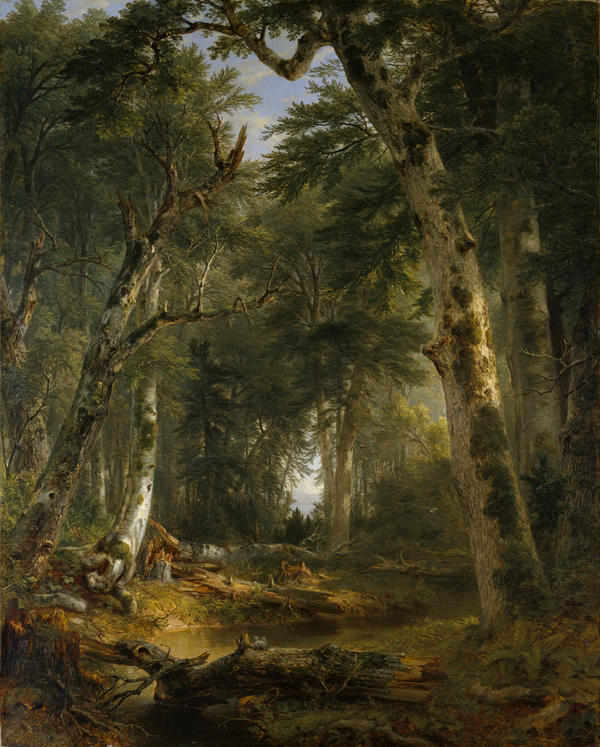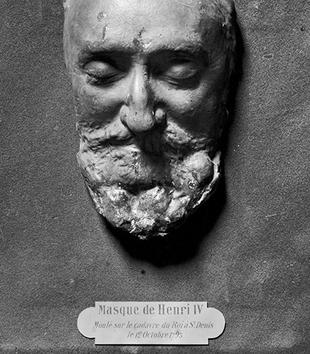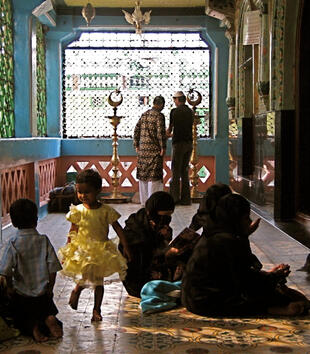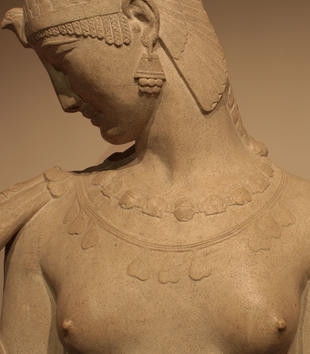In June 1840, Asher Durand, one of the most prominent American landscape painters of the nineteenth century, was aboard a ship bound from New York to London. He wrote in his journal: "Today again is Sunday. I have declined attendance on church service, the better to indulge reflection unrestrained under the high canopy of heaven, amidst the expanse of waters—fit place to worship God and contemplate the wonders of his power."1 This was Durand’s usual devotional practice throughout his adult life. As he explained it, a "rational man… needs no temple made with hands."2 It was in the midst of nature that one was closest to God. Approaching nature "with right-minded, reverent feeling," one could, Durand wrote (quoting his friend William Cullen Bryant), "To the beautiful order of his works/Learn to conform the order of our lives."3
In the Woods is Durand’s largest and most majestic expression of these ideas. Two trees, one dead, one living, lean inwards to form an arched opening to the forest interior. Beyond them other trees intertwine their branches to form a leafy canopy, the natural equivalent to the vaults of a cathedral. At the far end of this sylvan nave, where a church’s altar would be, the trees part to reveal a distant prospect of lake and mountains suffused in a luminous, glowing light, the sort of light that in nineteenth-century landscape paintings was consistently associated with the divine. Here, then, is the temple of nature.
Yet in contrast to the typical church interior, no smooth processional path stretches from entrance to altar. Instead, the forest aisle is cut by a stream and strewn with fallen trees, their decaying trunks lying across our path. They introduce a series of pauses into our progression through the scene. They invite us to move in measured steps, stopping every few feet to look and listen, to become aware of our surroundings. If we do pause, our attentive looking is rewarded with an abundance of rich detail: A chittering squirrel and a bed of lacy ferns in the foreground. Then, on the left, a red-headed woodpecker tapping on a beech tree in a pool of sunlight. Next a dark-needled hemlock, then a soft green light filtering through tree tops, and even a bird soaring across the scene, its wings lifted as though about to alight.
To engage in such absorbed contemplation of nature is to open our minds and hearts to what Durand described as nature’s "lessons of high and holy meaning."4 Here the intimate intertwining of life and death and the promise of immortality seem central. The coupling of a dead and a living tree in the foreground announces this theme. It is reinforced in the middle ground by the pairing of the shaded evergreen hemlock on the left with a leafy yellow-green deciduous tree on the right, bathed in sunlight.
Moreover, a series of tree stumps, their tops splintered and their heartwood crumbling, stretches from foreground to middle ground along the left bank of the stream. Their trunks have fallen across the stream, bridging the two sides of the picture. In the immediate foreground, a prostrate trunk leads directly from its rotting stump to a bed of ferns growing from the decaying matter of the forest floor. Here, in the natural cycle of death and rebirth, we see God’s continual renewal of his creation. Here we confront, as Durand wrote in his famous "Letters on Landscape Painting," "'the freshness of the far beginning’ of things which connects us with the past and symbolizes our immortality."5
Abundant evidence suggests that many of Durand’s contemporaries were attuned to the religious chords of his paintings. The Reverend Elias Magoon, for example, owned another of Durand’s forest interiors, very similar in composition to In the Woods (Through the Woods, 1856, Vassar College Art Gallery). He wrote of it: "As my eye rests on those great, calm children of the woods in the foreground, and then irresistibly falls back reach after reach through the glorious perspective to the still mightier hills in the remote distance, I have the fitting aisle of a majestic cathedral wherein to extemporize te deums and High Masses at my own sweet will."6



